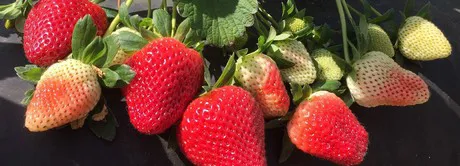For years, University of Florida scientists looked for a few characteristics in a more desirable strawberry. Among those traits was a higher yield in November and December — the early part of the Florida season when prices are highest.
They also sought better fruit for the consumer. That meant a longer shelf life, better flavor, improved shape and other traits, said Vance Whitaker, an associate professor of horticultural sciences at the UF Institute of Food and Agricultural Sciences.
After a lot hard work, and through traditional breeding methods, UF/IFAS researchers came up with ‘Florida Brilliance.’

“Our farmers need to produce more strawberries during this period in order to remain profitable,” said Whitaker, who breeds strawberries for UF/IFAS. “This variety has beautiful, flavorful fruit that is available consistently throughout the season, from Thanksgiving to late March in Florida, and thus on grocery store shelves in the eastern United States during this period. Much of the beauty of the fruit comes from its glossy, shiny appearance, thus the name ‘Florida Brilliance.’”
Adam Young, who runs a farm in Dover, Florida, said he’s using ‘Florida Brilliance’ on about 45 acres, which represents about 25 percent of his land. Thus far, he’s happy with the results.
“It takes the weather better,” Young said. “The fruit shape is more uniform. It definitely looks like we’re going to use it as our workhorse.”
Todd Jameson of Berry Bay Farms in nearby Wimauma, Florida, said rain does little damage to ‘Florida Brilliance’ strawberries.
“Vance has a winner with this one,” Jameson said.
Whitaker and his research team developed ‘Florida Brilliance’ through conventional cross-pollination, in which scientists choose two strawberry varieties as parents. Researchers chose the parent strawberries for their different but complementary characteristics.
They transfer pollen from one plant to the flower of the other using a camel’s hair brush and collect the seeds from the resulting strawberries. Scientists then grow a couple of hundred seedlings from each cross and evaluate them. They choose and test the seedlings with the best characteristics from both parents.
Farmers are growing ‘Florida Brilliance’ on about 1,500 acres in Hillsborough County, according to the Florida Strawberry Growers Association. That’s about 15 percent of the overall strawberry acreage in Florida. The previous record acreage for the first year of a new UF/IFAS strawberry variety was 500 acres for ‘Florida Beauty,’ and that was in 2017, said Whitaker, a faculty member at the UF/IFAS Gulf Coast Research and Education Center in Balm, Florida.
“This is definitely unusual and represents the high level of interest generated among growers from trials the last two years,” Whitaker said. “Growers tell us that this variety will replace the current standard ‘Florida Radiance’ as quickly as planting stock is available. Next year, 40 percent to 50 percent of the industry could be planted in this variety.”
For growers, ‘Florida Brilliance’ resists many diseases, and that cuts production costs, Whitaker said. It is also very easy to harvest because it has long stems and an open plant canopy that allows the pickers to see the fruit easily.
Labor is the largest cost in strawberry farming, so this is import, Whitaker said.
“The fruit are firm and resist bruising, allowing the grower to generate a better quality product,” he said. “For consumers it is the brilliant gloss and the freshness of the fruit that make it stand out.”
